Texas may be better known for having snakes than turtles, but the state is home to quite a few shelled reptiles. They can be found all over the state, from the deserts in the west to the marshes in the east, and many call the various lakes, rivers, and streams in the state home.
There are several dozen different species of turtle in Texas, ranging from the numerous to the endangered. If you’d like to learn more about the wonderful reptiles in the Lone Star State, read on.

The 10 Turtles Found in Texas
1. Desert Box Turtle

| Species: | T. ornata luteola |
| Longevity: | 30 years |
| Good to own as a pet?: | Yes |
| Legal to own?: | Yes |
| Adult size: | 4–6 inches |
| Diet: | Omnivorous |
The Desert Box Turtle is often found in the southwest portion of the state, and they enjoy open habitats. They enjoy any sort of vegetation that they can find in those arid desert locales, and they like to stick to a defined area, where they can be aware of everything around them.
These turtles are known for their boxy shell; their bones actually fuse to their shell, and they can create a tight seal when they retreat inside. This makes them a tough meal for predators, but raccoons, coyotes, skunks, and snakes will all give it the old college try from time to time. They’re omnivorous by nature, but insects make up the bulk of their diet, especially dung beetles.
2. Chicken Turtles
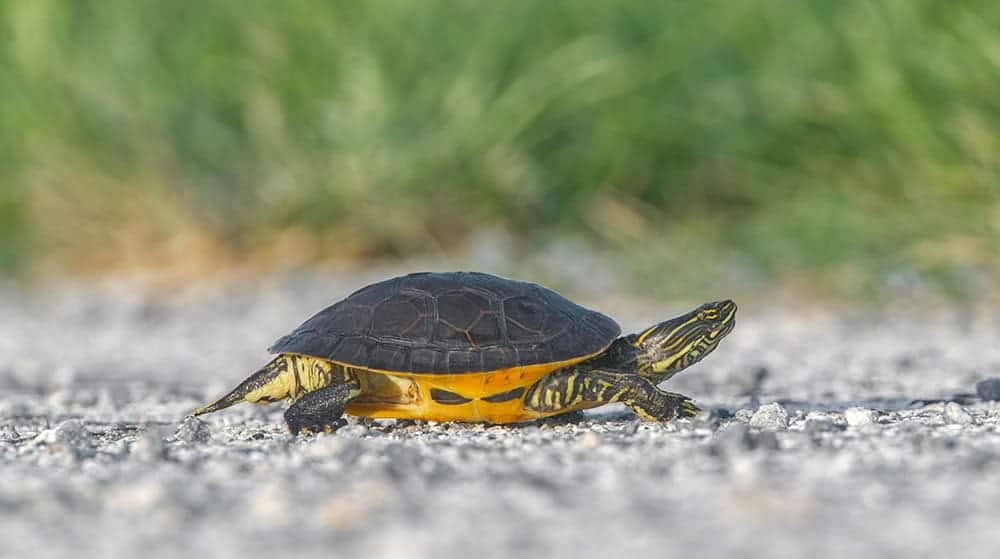
| Species: | D. reticularia miaria |
| Longevity: | 30 years |
| Good to own as a pet?: | Yes |
| Legal to own?: | Yes |
| Adult size: | 4–10 in |
| Diet: | Omnivorous |
These turtles used to be a popular form of meat for people in the southwest, and yes, they supposedly taste like chicken.
They spend most of their time in slow-moving waters, and they have a long, striped neck and stripes on their legs. However, they’ll often wander around on land, where they’ll burrow down into cool dirt when it gets too hot. They’ll even hibernate in the mud.
They eat crayfish, fruit, insects, frogs, plants, and more. Besides chicken-hungry humans, they have to worry about moles, raccoons, and snapping turtles.
3. Missouri River Cooters
| Species: | P. concinna metteri |
| Longevity: | 40 years |
| Good to own as a pet?: | Yes |
| Legal to own?: | Yes |
| Adult size: | 7–12 in |
| Diet: | Omnivorous |
These large, semi-aquatic beauties can be found in rivers and streams throughout the state, but they primarily congregate in the eastern portions of Texas. They’re basking turtles, so they can often be found sunning themselves on rocks or lounging on riverbanks.
They’re sociable, so if you see one, it’s likely that there are several more nearby. You’d better look quickly, though, as they’ll zoom right back into the water at the first sign of trouble.
They’re omnivorous, but they prefer to eat aquatic plants. They’ll chomp on insects, snails, and crayfish if given the chance, though. There are plenty of animals that will happily eat them, but their biggest predators tend to be herons, large fish, and raccoons.
4. Cagle’s Map Turtle
| Species: | G. caglei |
| Longevity: | 50 years |
| Good to own as a pet?: | Yes |
| Legal to own?: | No |
| Adult size: | 3–10 in |
| Diet: | Carnivorous |
Named after famed American herpetologist Dr. Fred Ray Cagle, Cagle’s Map Turtle is an ornately patterned turtle that primarily lives in the Guadalupe River near San Antonio.
In fact, that patterning is what gives them their name, as they look like they have maps on their shells. They’re small, averaging around 3 inches, although females can be significantly bigger than males. While they make great pets, you’re unlikely to ever know that first-hand, as their threatened status makes them illegal to own.
They’re technically omnivores, but many experts believe that most of the plants they eat are incidental, as they prefer to snack on fly larvae, snails, and aquatic insects that are often found living on aquatic plants. They’re vulnerable to raccoons, snakes, and large fish.
5. Eastern Mud Turtle

| Species: | K. subrubrum |
| Longevity: | 50 years |
| Good to own as a pet?: | Yes |
| Legal to own?: | Yes |
| Adult size: | 3–5 in |
| Diet: | Omnivorous |
Eastern Mud Turtles have plain brown shells — the better to blend in when they bury themselves in dirt and mud. They spend most of their time on land because they’re not strong swimmers, preferring to walk on the bottom of slow-moving streams or densely vegetated ponds. They’ll hibernate in forests, buried under leaves.
They’ll forage for food while walking around on the bottom of those streams and ponds, preferring to eat insects, mollusks, and even carrion. They also eat vegetation but they prefer to eat meat.
Raccoons will eat their eggs, but these turtles only have two major predators once they’re fully grown: alligators and herons.
6. Common Musk Turtle

| Species: | S. odoratus |
| Longevity: | 50 years |
| Good to own as a pet?: | Yes |
| Legal to own?: | Yes |
| Adult size: | 4–5 in |
| Diet: | Omnivorous |
The names of this animal are “Common Musk Turtle” or “Stinkpots,” and its scientific name includes the word “odoratus.” That’s because this turtle will release a foul-smelling musk when threatened.
They have stripes on their heads and dark brown or black shells. They like shallow, slow-moving waters, and they rarely bask or leave the water. They’re most active at night, when they can often be seen crossing roads (often unsuccessfully).
These turtles will eat seeds and grasses, and they also graze on insects, snails, tadpoles, and the occasional dead fish. Predators include raccoons, skunks, birds, bullfrogs, and other turtles.
7. Painted Turtles
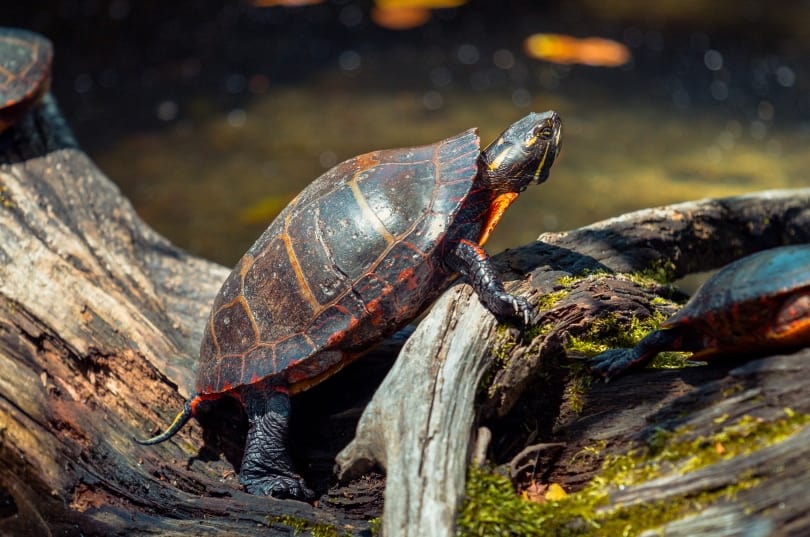
| Species: | C. picta |
| Longevity: | 50 years |
| Good to own as a pet?: | Yes |
| Legal to own?: | Yes |
| Adult size: | 4–10 in |
| Diet: | Omnivorous |
The painted turtle gets their name from the fact that they have a dark shell with a single painted band down the middle. These aquatic turtles rarely leave the water, and they can often be found basking on banks and rocks. They’re primarily found near Louisiana, especially in Caddo Lake.
This is an old species, as it’s believed that they’ve existed for as long as 15 million years. That may be due to the fact that their hard shells protect them from most predators, although their eggs are often targeted by snakes, rodents, and birds.
They eat some plants, but they prefer mollusks, insects, and frogs. They’ll also eat larger prey if given the chance, holding it with their forefeet and ripping flesh off with their jaws.
8. Big Bend Slider
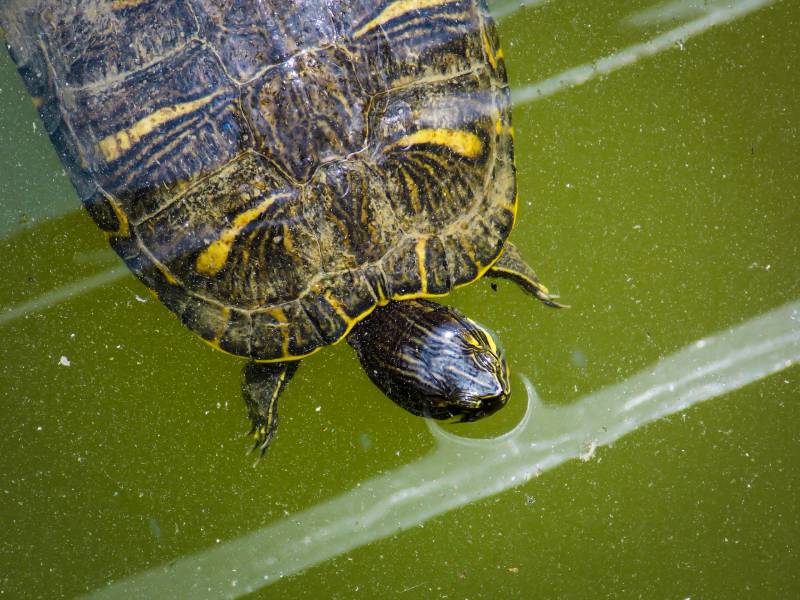
| Species: | T. gaigeae |
| Longevity: | 30 years |
| Good to own as a pet?: | Yes |
| Legal to own?: | Yes |
| Adult size: | 5–11 in |
| Diet: | Omnivorous |
Found in and around Big Bend, these sliders are often mistaken for their more common cousins, the red-eared slider. They’ll live in any body of water in the area, although they spend much of their time basking next to the water rather than in it. That changes if they feel threatened, however, as they’ll quickly dive to the bottom.
These animals are omnivorous, but they tend to be almost exclusively carnivorous as juveniles before becoming increasingly herbivorous as they get older. Their primary predators are coyotes, but they can be eaten by birds, snakes, and frogs as eggs or hatchlings.
9. Alligator Snapping Turtle
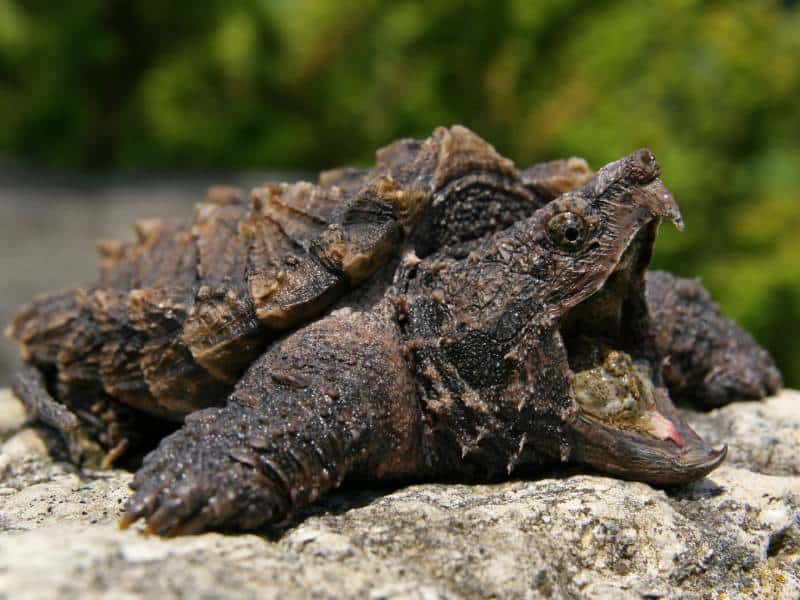
| Species: | M. temmincki |
| Longevity: | 70 years |
| Good to own as a pet?: | No |
| Legal to own?: | No |
| Adult size: | 15–25 in |
| Diet: | Carnivorous |
These massive, terrifying turtles are the stuff that nightmares are made of. The largest freshwater species in the world, these critters have huge heads, ferocious beaks, and plated shells.
The largest alligator snapping turtle on record was 249 pounds, although there have been reports of them getting as big as 400 pounds. They can bite off a broom handle or more terrifyingly, human fingers, so don’t get cute with them.
They lure fish to their demise by wiggling their tongue, which looks like a worm. They’ll also eat snakes, frogs, insects, and sometimes even small alligators. Rodents like squirrels and armadillos can also fall prey to these turtles if they get too close to the water.
They don’t have many predators (outside humans) once fully grown, but they are often eaten by birds and mammals as eggs.
10. Midland Smooth Softshell Turtle
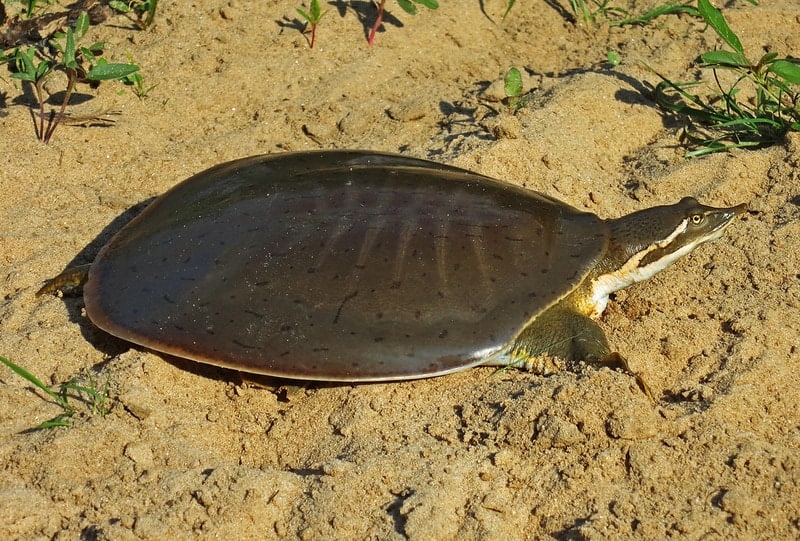
| Species: | A. mutica mutica |
| Longevity: | 25 years |
| Good to own as a pet?: | Yes |
| Legal to own?: | Yes |
| Adult size: | 4–14 in |
| Diet: | Carnivorous |
This species looks more like a slow-moving pancake than a turtle, and their shell color will vary throughout their lives, depending on their age and sex. They’re incredibly fast swimmers with sharp claws, so they’re quite able to defend themselves even though they lack hard shells.
They live in large streams and lakes, and they rarely leave the water. They eat insects, mollusks, and crayfish, and they often fall prey to skunks, raccoons, snakes, and some birds.
This species can actually breathe underwater, but they spend most of their time in sandbars, where they can just poke their heads above the water when necessary. They can be found all over Texas, but they’re not common in the eastern portion of the state.

Conclusion
Turtles are wonderful creatures because they can be fascinating to watch even when they’re not doing much. The various species that you’ll find in Texas run the gamut from small and adorable to huge and nightmare-inducing, but they’re all exceptional in their own way.
Also See:
Featured Image Credit by J.Rangubphai, Shutterstock
